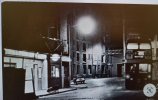The East London Line was the nearest bit of the Underground to what was my part of London, although I didn't use it very often until I started using it once or twice a week in the late 80s, prior to that, I just saw trains (sometimes) when passing through New Cross on the way to central London.
I don't remember seeing 1938 tube stock on the line (ran for some years in the 1970s, but not sure exactly when, so probably before I was taking much notice) - I remember it being two person operated A stock, then D stock (think the driver only conversion happened fairly soon after the D stock arrived) then reverted to A stock (after it had been converted to driver only mode.)
I don't remember it ever being as low as 2 trains per hour on each branch but can't say for certain that it never was that. (I don't remember ever thinking it would be quicker southbound to go to New Cross Gate and walk down the road if I missed a New Cross train, for example.)
I have a 1976 working timetable to hand - this has a 10 minute headway (20 at New Cross / Gate) off peak, evenings and Sundays (required 3 trains in service) and 6 1/2 minute headway (13 at New Cross / Gate) in the weekday peaks (which required 5 trains.) Shoreditch was only open 0704 - 0945 and 1554 to 1842 (that's what the working timetable says) Mon - Fri, although one early morning Saturday train ran empty to and from Shoreditch for reasons which aren't clear. (I have read somewhere else that the Shoreditch Station building included a small LT canteen which was used by Dalston Garage route 47 bus crews to save on travelling time back to the Garage for meal breaks - it's possible this journey was for canteen staff to get there and open up, although would have thought the timetable would have shown it as 'staff' rather than 'empty'.)
I can vaguely remember the Sunday extension to Shoreditch starting - think it was mid / late 80s? And it was only until about 2 pm, when the Sunday markets wound down.
Shadwell also had limited hours - 0615 to 2200 Monday to Saturday (in the 1976 timetable) and I think this was still the case for some time after the station offered an interchange with the DLR - I remember doing that once and being quite fortunate but surprised in catching the last southbound train (from Shadwell) of the day.
At the times I remember it, the off peak service used the northbound platform at Whitechapel to terminate. (The 1976 timetable suggests this was the case then, with a few terminating trains using the southbound platform to allow the next northbound train to continue to Shoreditch.)
I must have moved away from London before it went up to 10 trains per hour. (How many trains did that need to run it? And where did they put them all? I thought the depot was only big enough for 6 trains.)

